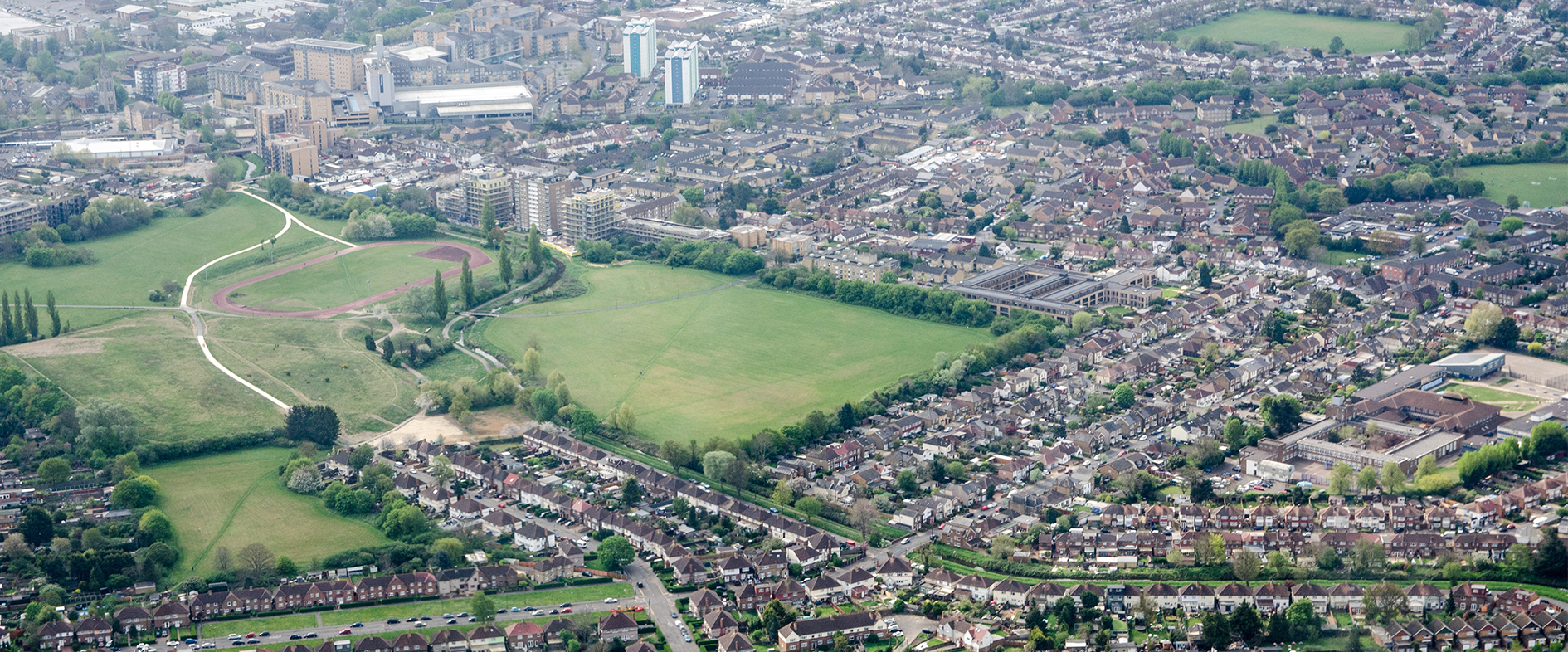Blog Archives
Post navigation

Thames Tideway Tunnel
Our geospatial strategy and using GIS throughout the life of the Tideway project, has given us consistent means of engagement with every single stakeholder, from construction partners to community groups and local authorities.
London’s super sewer is designed to protect the River Thames and serve London’s residents for the next 120 years. GIS has been used on the project from the start, providing a huge range of applications for enabling and recording activities while providing one platform for stakeholder engagement, helping Tideway to manage and monitor this extraordinary infrastructure project with greater efficiency.
One single repository for data accessed by all delivery partners supports better decision-making and better outcomes
Public engagement tools such as StoryMaps are hugely successful, with up to 2.4 million hits for the Tunnel Boring Machine Map alone
Apps and dashboards can be quickly spun up, presenting data in easily digestible formats supporting all business and construction requirements
The Challenge
During the scorching summer of 1858 an episode known as ‘The Great Stink’ took place in Victorian London. The smell of human waste and industrial effluent pouring into the River Thames reached an unbearable level, even the Houses of Parliament was affected. The politicians acted, and the result was the extensive Victorian sewer network, an engineering marvel of its time. However, it was designed to serve the needs of four million people, not the nine million residents and workers who currently rely on the system.
Unsurprisingly, every year, the equivalent of eight billion toilet flushes enter the Thames in central London. But the long wait for London’s Super Sewer is almost over; at 25km long and 7.2m in diameter, running mostly under the tidal section of the Thames and due for completion in 2025, it will capture, store and convey almost all the raw sewage and rainwater that currently overflows into the estuary. It has been designed to protect the river for at least the next 120 years.
Bazalgette Tunnel Ltd (BTL) is the licensed infrastructure provider set up to finance, build, and maintain the Thames Tideway Tunnel. Back in 2011 the project team, commonly known as Tideway, identified that a geospatial strategy was vital to the success of this massive infrastructure project.
Esri’s ArcGIS System has supported Tideway’s needs during every phase of the project from concept planning with Desktop GIS, implementing web mapping supporting the public planning hearings in 2013 in the early days of digital construction to a modern, integrated information management portal-based tool.
“Geospatial is the one discipline that ties different elements of the project together. Our GeoViewer platform remains a key tool that everyone from accountants and engineers, to the public viewing our latest work, have access to and use.”
Martin Turner, GIS Manager, Tideway
The Solution
Tideway’s geospatial strategy means that the company can deliver one consistent means of engagement with its stakeholders including its three construction joint venture partners, the systems integrator, Thames Water - the future operator - as well as government, public and community groups. At any one time, hundreds of Tideway and partner colleagues use the centralised information portal, GeoViewer, where data pertaining to many aspects of the project can be accessed. This includes, but not exclusively, planning records, tender selection and the acquisition of construction sites, riverbed surveys and construction progress tracking.
GeoViewer has been used at every single stage of Tideway, one of Europe’s biggest environmental infrastructure projects, and gives users a quick, simple and easy way to share and view data and interrogate the status of activities. Maps and dashboards provide intuitive means of sharing information, and tools to run business functions as well as supporting workflow management are used by more than one in three people involved in the project, from accountants to engineers on the ground.
During the public planning enquiry in 2013, the web platform was used as a tool for participants to view hundreds of digital maps, rather than producing analogue printed versions, saving time and money during the hearings and speeding up the Development Consent Order process. Additional tools were added when the project tendered for construction and supporting services, enabling the Tideway team to plan for and visualise the next five-year cycle and beyond sharing the same, consistent information with its partners.
As ArcGIS Enterprise itself developed, GeoViewer’s functionality became further enhanced. Web applications were built to record and support different enabling activities including land acquisition, site preparation and environmental consents. Dashboards have been quickly spun up to clearly show progress of works and activities. The GeoViewer platform also ensures that all plans and activities are retained and can be archived, fulfilling regulatory requirements and enabling Tideway to fulfil its statutory obligations.
ArcGIS Online continues to be used principally for public engagement with the publication of StoryMaps, such as the live-screen dataset map published during the tunnelling period, letting the public see the location of the tunnel boring machines during different stages excavations. This one StoryMap gained over 2.4 million hits in the four years it ran live.
“Having this one-stop-shop capability means we are so much more efficient. Costs would have been considerably greater, and deliverability compromised, without GeoViewer. It has vastly improved the way we manage land and property access as well as consenting with local authorities.”
Stuart Grant, Head of Commercial Agreements & Property, Tideway
Benefits
Improved outcomes
Having one, single repository for data means that all stakeholders have access to the same information across the entire project, from beginning to the end. Consistent, accurate data reduces the risk of data duplication and potential for error, helping all four joint ventures and stakeholders to make better decisions, contributing towards the best possible outcomes for a successful project.
Enhanced community engagement
Details and activities can be shared externally through tools including StoryMaps resulting in high levels of public engagement such as the 2.4 million hits for the Tunnel Boring Machine Map.
Fulfilling regulatory requirements
The GeoViewer portal consolidates all records of activity throughout the duration of entire infrastructure construction process, creating a contemporaneous history of what happened, when and why. These evidential records of activity can be quickly and easily accessed and referred to as required, acting as a record of proof and demonstrating that all regulatory requirements have been met.
Speed of deployment
The GeoViewer platform has supported Tideway during every single phase of the project. The ability to quickly spin up tools and dashboards means that all business needs are supported as and when required and having a centralised view in an easily digestible format means Tideway can monitor overall efficiency, with users needing no specialist GIS skills to access information.

AtkinsRéalis
We are using ArcGIS Portal, ArcGIS Pro and ArcGIS Field Maps to drive the AtkinsRéalis SpatialCDE, used by multiple stakeholders to make construction projects more efficient while driving Biodiversity Net Gain.
Infrastructure renewal and growth are vital to economic and societal growth and, thanks to new methodologies, biodiversity enhancement can sit parallel to these aims. The AtkinsRéalis SpatialCDE platform (or Spatial Common Data Environment) uses a technology stack including Esri to deliver huge qualitative and quantitative benefits while supporting Biodiversity Net Gain.
More efficient data collection and management saves each project £300,000 per annum
Quickly developed custom tools deliver £40,000 in cost savings per quarter, per tool
A 1000 per cent increase in Biodiversity Net Gain is projected thanks to use of this technique on one project
The Challenge
Biodiversity Net Gain (BNG) strategies have been introduced to mitigate against the impact of construction projects, and the Environment Act 2021 makes BNG mandatory for all but small sites with Environmental Impact Assessments (EIA). However, the legislated requirements can be complex and time consuming. The process is constantly changing, and it can be difficult for developers and their partners to keep pace.
AtkinsRéalis’ Geospatial team observed that, at any one point, there could be up to 500 people working on large development projects such as a road design or rail construction, and every individual team member requires the most accurate, up-to-date data. This could be within a single large multidisciplinary organisation or spread across multiple contractors. And the specialties required use vastly different techniques, terminology and task plans; an ecologist surveying badger setts for instance, versus a civil engineer considering the curve of a junction. Offering the same centrally managed data to all is a challenge, but also an opportunity for enhanced collaboration, and development of innovative methods such as BNG analytics.
When designing its SpatialCDE in 2015, AtkinsRéalis identified the opportunity for major process improvements; what was required was a standardised, geospatial approach to improve workflows, bring context to reporting and increase collaboration across all the contractors on any one project. The development of a common SpatialCDE techstack has enabled design and roll-out of multiple tools, frequently utilitising the ArcGIS python powered widgets within interactive WebApps.
“Our Spatial CDE system gives colleagues an incredibly rich user experience. ArcGIS puts data in the real world and enables us to make significant process improvements while delivering impressive cost and resource savings.”
Elspeth McIntyre, Geospatial Associate Director, AtkinsRéalis
The Solution
AtkinsRéalis knew that the ArcGIS System offered the versatility it required to create an integrated digital geospatial platform and data system. The resultant AtkinsRéalis SpatialCDE (Spatial Common Data Environment) combines spatial analysis techniques with qualitative assessments, enabling a broad range of specialists working on any one construction project to share data, insights and knowledge.
Field workflows are now streamlined with ArcGIS Field Maps, which is downloadable to any mobile device. Ecologists use map-driven mobile forms to capture different assets and observations to complete their work efficiently and accurately. Data is automatically uploaded to the AtkinsRéalis SpatialCDE and, where there is no reliable data connection, they can continue to work offline.
Portal for ArcGIS allows users across a complex project to access the AtkinsRéalis SpatialCDE with a simple log-in and, with its gallery of spatial apps including Map Viewer and ArcGIS Dashboards, view and analyse data collected in 2D and 3D. A custom integration of FME and Microsoft Azure enables the data management toolbox used to manage both primary data collection, and data collated from other sources such as the Environment Agency. The whole platform is aligned with ISO 19650 and is BIM Level 2 compliant.
Flexibility is another important requirement for the AtkinsRéalis team. The FME server back end allows the team to update any legislative changes or project requirements. Using ArcGIS Python libraries, the team can build custom tools quickly and easily, vital for new Environmental Risk Assessments, and for Bio Net Gain. These can now be spun up in a matter of hours, rather than the weeks previously taken.
AtkinsRéalis initially integrated Esri’s ArcGIS System into the SpatialCDE in Europe in 2021. Since then, access has been widened to Canada and the USA, as well as to colleagues in the Middle East, and plans include extending the Spatial CDE to teams in the Asia Pacific region.
“A geospatial approach via the AtkinsRéalis SpatialCDE is vital to make construction projects more efficient while driving Biodiversity Net Gain. We all have a responsibility to protect our Natural Capital and mitigate against the impact of economic and societal growth.”
Harriet McQuade, Geospatial Business Lead, AtkinsRéalis
Benefits
Tangible cost and time savings
More efficient workflows and vastly improved data management is saving projects in the region of £300,000 per annum. Ecologists spend less time collecting data and have their time freed up to explore new processes and deliverables. Custom tools are deployed more quickly, each one saving £40,000 per project per quarter. Future plans include daisy-chaining to support further automation.
Gains for biodiversity
Using a proactive analysis approach, making BNG assessment within projects faster and more effective, and at reduced financial and environmental cost, AtkinsRéalis has achieved a potential 1000 per cent increase in BNG on one project alone. Taking a geospatial analytical approach mitigates against unnecessary damage and delays during the construction process, while identifying areas to conserve.
Enhanced data quality and decision-making
Improved data collection, both in speed and quality, makes it easier for ecologists on the ground to work more efficiently and effectively. Accurate and timely data is quickly and easily shared across multiple teams and organisations, further enhancing the decision-making process.
Ease of use
No specialist training is required to access the SpatialCDE, and its intuitive user interface makes it easy for new users to become familiar with interrogating data. As a one-stop-shop the SpatialCDE supports all spatial and statistical data needs, with easy-to-share maps and dashboards that improve everyone’s understanding of the project in hand.

Anglian Water
We are reducing pollution and flooding risks through the use of ArcGIS solutions.
Anglian Water has successfully targeted £1 million in cost savings by using Esri’s ArcGIS system to implement a new proactive sewer maintenance business model. Through this new approach, it has reduced sewer blockages by 51% and significantly decreased the risks of flooding and pollution.
ArcGIS Online provides an accurate digital twin of Anglian Water’s water and waste water network
ArcGIS Dashboards provide clear visualisations of hotspots of potential risk for flooding and pollution
ArcGIS mobile solutions help engineers to find assets and understand water movements
The Challenge
The largest water and water recycling company in England and Wales by geographic area, Anglian Water is committed to improving the sustainability of its operations. Driven by its ethos ‘Love Every Drop,’ it aims to reduce water leakage and deliver a high quality service to its seven million customers.
Like other water companies across the UK, it is challenged by climate change. In particular, extreme weather events are leading to increased flooding and pollution. Anglian Water wanted to be able to better manage these risks and plan maintenance works more proactively to help it protect the environment.
“In the first year of operations, we have targeted a million pounds’ worth of saving.”
Michael Wingell, Geospatial Strategy Manager, Anglian Water
The Solution
Anglian Water uses solutions from Esri’s ArcGIS system to help it visualise and manage the entire water cycle, from supplying and distributing it to customers’ taps to treating it and putting it back into rivers. Providing a digital twin of the water and waste water network, ArcGIS is used both on desktops and in the field, where engineers refer to ArcGIS mobile apps on tablets to find assets and understand how the water is moving.
One of the organisation’s most recent innovations with ArcGIS is a Water Recycling Risk Tool that enables employees to better understand where future flooding and pollution events are more likely to occur. The tool analyses the performance of sewers according to fifteen risk factors, ranging from material, size, proximity to the water course, historic pollutions, floodings, blockages and proximity to bathing areas. The results of this analysis are then visualised on interactive maps in ArcGIS Online.
Employees use operational dashboards, created with ArcGIS Online, to gain full visibility of risks and interrogate the data. Using these dashboards, employees can easily see hotspots of potential risk highlighted on digital maps. They can then plan proactive risk mitigation activities and proactive maintenance strategies, rather than relying predominantly on reactive approaches, such as fixing sewers when pollution events occur.
Anglian Water plans to further develop its Water Recycling Risk Tool in the future by incorporating telemetry data from remote sensors, machine learning and AI tools. In this way, it aims to give employees a real-time view of what is going on across the network, so that they can further improve their ability to predict where pipe bursts and blockages might occur.
“By embedding digital technology into the decision-making processes within our business, we can drive change and improve performance.”
Victoria Wilkinson, Strategy Manager, Anglian Water
Benefits
Effective implementation of proactive risk mitigation
Through the development of its Water Recycling Risk Tool, Anglian Water has been able to successfully change its business model from reactive interventions to proactive risk mitigation. As Laura Hinchcliffe, Geospatial Reporting Manager, explains, this is helping it to address the challenges of pollutions and floodings. “We want to make sure that we are protecting the environment and our customers,” she says. “With ArcGIS, we are able to display our data clearly and visually. We can, therefore, identify where our hotspots are and target them proactively.”
£1 million in cost savings
The new proactive approach has led to a reduction in customer service issues relating to blockages and has contributed to significant cost savings. Engineers have one single source of the truth, so less time is wasted on unnecessary callouts and aborted works, and carbon emissions are reduced. “The project has been a massive success,” says Michael Wingell, Geospatial Strategy Manager at Anglian Water. “In the first year of operations, we have targeted a million pounds’ worth of saving.”
51% reduction in blockages
Just six months after the Water Recycling Risk Tool was deployed, Anglian Water reduced blockages by half, with just 436 blockages recorded, as compared to the 899 that were predicted. “We’ve had a 51% reduction in blockages and moved 8 tonnes of debris, which is more than the size of five blue whales,” says Wingell. “Yet, I feel like this is only the start of the journey in terms of how we use the risk tool. As we develop more and more data sets, it will allow us to much better target sewers accordingly.”
Well-informed decision-making
The use of ArcGIS Online Dashboards improves data sharing throughout the organisation, ensuring all stakeholders are making decisions based on the same up-to-date information. As information is available on demand, on digital maps, decisions can also be made more quickly and teams dispatched immediately to the exact locations of events like flooding incidents. Victoria Wilkinson, Strategy Manager at Anglian Water, comments: “By embedding digital technology into the decision-making processes within our business, we can drive change and improve performance.”

Thames Water
We are proactively addressing the data sharing requirements, and the needs of internal and external stakeholders with our end-to-end geospatial portal, built with ArcGIS Enterprise and ArcGIS Online.
Thames Water has proactively addressed the needs of its data sharing requirements by building an end-to-end geospatial portal, centralising data sources, allowing for internal and external stakeholder feedback, interaction and knowledge sharing all of which are helping to shape and drive commercial decision-making.
Datasets from multiple sources are centralised giving internal and external stakeholders one single view of all data
Access to previously hidden insights supports evidence-based analysis and more confident predictive modelling
Improved business efficiencies include massive time savings with internal requests now delivered in weeks rather than six months
The Challenge
Responsible for moving seven billion litres of water and wastewater as part of its daily water cycle, through 31,000km of managed water mains and 109,400km of managed sewerage mains, Thames Water serves 15 million wastewater customers across London and the Thames Valley.
Its ability to extract and gain optimum value from different data sources is integral to supporting its ability to extend, improve and maintain robust and resilient drainage and wastewater systems while fulfilling its regulatory requirements, including the Drainage and Wastewater Management Plan (DWMP). Regulatory body Ofwat also requires water companies to demonstrate open and trustworthy data ecosystems.
At the outset of developing its data sharing portal, Thames Water was faced with colossal amounts of data from a multitude of internal and external sources. “We had so much data only available to a small group of users, it was difficult to visualise or understand it,” said Graeme Kasselman, London System Planning Lead. To solve this complex challenge the company identified the need for a technology platform that could incorporate this data all in one place and give internal and external stakeholders the ability to analyse and inform predictive planning, while providing the public with an engagement portal to provide their input.
“ArcGIS and Data Interoperability extension was fundamental to converting complex hydraulic modelling outputs into spatial insights that could then be shared with key stakeholders.”
Zeshan Alli, GIS Specialist, Asset Strategy & Planning, Modelling & Insight, Thames Water
The Solution
In the co-creation of its DWMP, Thames Water worked with around 2,000 partner organisations and stakeholders on national, regional and local levels as well as the general public. To fulfil its DWMP obligations, Thames Water identified three critical deployments that could be built using ArcGIS Enterprise for internal and ArcGIS Online for external data management, access and collaboration.
These deployments needed to be quick and streamlined, offer different levels of access and be easy to update. “We have a principle within our teams to use COTS products, though we also need the ability to deliver on specialised requirements,” said Louise Bates, GIS Architect for Thames Water.
The System Planning Portal, the heart of the data sharing portal, resides in ArcGIS Enterprise and provides the single, central data repository. The GIS team used ArcGIS Pro and ArcGIS Data Interoperability Extension Tool to perform the detailed analysis required and then prepare the data, which was passed to the platform team to publish content including layers, services and maps in the apps, making it securely available to a wider internal audience. This System Planning Portal also ensures that the DWMP is reflective of the combined views of technical specialists incorporating external datasets like the CAMELLIA (Community Water Management for a Liveable London) project.
The Practitioners DWMP Portal is an external enterprise platform, using data from the System Planning Portal. Views are replicated from the System Planning Portal, such as hotspots, but with anonymised data attributes thereby preventing the release of data which may have an adverse impact on an individual or property.
This partnership working tool ensures that the DWMP is reflective of the combined views of technical specialists especially Lead Local Flooding authorities and River Catchment Partnerships, while optimising overall efficacy of the plan.
The Customer Portal, built in ArcGIS StoryMaps is an external public resource giving non-specialists the ability to view the DWMP, gain access to data and input ideas and share data. A series of interactive maps provide complete transparency of reporting from initial catchment screening and risk assessments to the main outputs of the final plan.
“By taking a geospatial approach, our portal confidently shows how citizen engagement and stakeholder involvement can influence and inform commercial activities, for the benefit of all parties.”
Graeme Kasselman, London System Planning Lead (Wastewater), Thames Water
Benefits
Optimising value from data
Diverse datasets from multiple sources are now centralised in one single, end-to-end solution, giving users the ability to analyse, plan and undertake predictive modelling fundamental to the evolution of the DWMP. Different layers can be analysed that show previously hidden insights, helping the business to better understand what it needs to do to support better operational performance and improve customer satisfaction.
Enhancing stakeholder involvement
The System Planning Portal, Practitioners DWMP and Customer Portals all deliver on data sharing requirements which include access to comprehensive, evidence-based and transparent data. Internal and external stakeholders are empowered with unprecedented, secure access to the same data, analysis and views while the general public can interrogate, interact with and share data for submission.
Improved business efficiency
ArcGIS Enterprise and ArcGIS Online mitigate the need for different software solutions and the GIS team now has the tools and views making it easier to implement updates. Ready-to-go capabilities and tools limit the need for coding, so that internal requests can be responded to in a matter of weeks rather than six months, helping to add value to the business.
Driving collaboration with stakeholders
Both portals and the ArcGIS StoryMap are driving collaboration both internally and externally. Stakeholders have access to the same data, though at different levels of detail for optimal security, enabling the company to present a fully transparent, evidence-based picture of its operations and future planning frameworks to all its stakeholders, while addressing regulatory requirements.

Fauna & Flora
Creating a single GIS platform for the whole organisation with ArcGIS has led to a 580% increase in GIS usage and transformed the way that we analyse, visualise and communicate conservation priorities.
In critical conservation projects all around the world, the international nature conservation charity Fauna & Flora uses Esri’s ArcGIS system to better understand the risks for threatened species, monitor changes in landscapes and prioritise intervention initiatives. Used by 175 staff across 20 countries, ArcGIS empowers everyone to make the best possible decisions and save nature.
ArcGIS Pro is used to analyse geospatial data and gain insight into conservation challenges
Landscape changes and trends are visualised on ArcGIS web apps, dashboards and story maps
Data is collected within conservation areas using ArcGIS Survey123 on mobile devices
The Challenge
Fauna & Flora works to protect all kinds of nature from pygmy hippos and turtles to ancient magnolia trees and seagrass meadows. Through partnerships with local communities, the charity addresses some of the most challenging global issues, including habitat destruction, illegal poaching and plastic pollution.
In conservation projects in Africa and the Asia-Pacific, around 30 conservationists had begun to use open-source geographic information system (GIS) software to map habitat changes. Outside of these small pockets of GIS usage, however, the technology was not widely known within the organisation and there was no common approach. “There were other teams who were not using GIS and didn’t know that they needed it,” explains Harriet Branson, Technical Specialist, Remote Sensing and GIS, at Fauna & Flora. “We wanted to make a wider range of GIS capabilities available to everyone and have a single GIS strategy for the whole organisation.”
“Being able to analyse data in a robust, accurate way is what makes conservation work.”
Harriet Branson, Technical Specialist, Remote Sensing and GIS, Fauna & Flora
The Solution
After evaluating different options, Fauna & Flora opted for Esri’s ArcGIS system, recognising that it offered a complete package of desktop, online and mobile solutions for analysing geospatial data, collecting data, story-telling, monitoring change on dashboards, sharing data via web maps and storing data centrally. “We felt that having a full range of GIS tools and capabilities, all in one place, would boost the accessibility and use of GIS throughout our organisation,” recalls Branson.
The Conservation Technology Team at Fauna & Flora implemented ArcGIS Online and ArcGIS Pro, utilising the Esri UK training catalogue. It then organised live training sessions, with follow-along activities, to make regional teams aware of the ArcGIS capabilities available to them and show them how to best use their new GIS resources.
Almost immediately, the number of people using GIS internationally doubled from 30 to 60 and, within four years, there were more than 175 people using ArcGIS across 20 countries. These employees now use GIS for far more than just map generation, taking advantage of the full the range of ArcGIS solutions to gain insights, streamline data collection in the field, aid collaboration and improve data sharing.
In north west Liberia and southern Guinea, for example, Fauna & Flora used ArcGIS Pro classification tools on the desktop to create landcover mapping at three time intervals between 2000 and 2019. The regional team then used ArcGIS Survey123 on mobile devices to verify existing land cover conditions and conducted further analysis with ArcGIS Online to identify priority restoration areas, including wildlife corridors.
Fauna & Flora has developed a host of ArcGIS web apps and ArcGIS StoryMaps to aid communication and raise awareness of conservation projects. Visually stunning and highly compelling, two of its StoryMaps have been named as finalists in Esri’s global StoryMap competition: The Guardians of Cao Vit Gibbons; and Community-Based Wildlife Crime Prevention.
“ArcGIS allows us to visualise the landscape, monitor patterns across time and location, and see more clearly where conservation activities are urgently needed.”
Harriet Branson, Technical Specialist, Remote Sensing and GIS, Fauna & Flora
Benefits
Deeper insight into conservation challenges
The creation of a single organisation-wide GIS platform triggered a massive uplift in the use of GIS. Geospatial data analysis is now routinely used to inform a wide range of conservation projects and has revealed far deeper insight into the challenges of climate change, pollution, deforestation and habitat loss. “Being able to analyse data in a robust, accurate way is what makes conservation work,” explains Branson. “We can now properly understand deforestation risks and how are species moving across the landscape and all this knowledge allows us to implement effective conservation strategies in the right locations.”
More efficient data collection and data sharing
By using ArcGIS Survey123 on mobile devices, instead of paper-based survey methods, Fauna & Flora has significantly improved the efficiency of its data collection workflows and achieved a tenfold increase in data sharing between in-country teams and the charity’s UK headquarters. In Uganda, for instance, monthly primate species surveys are now available for analysis in the UK and Uganda almost straight away, saving at least five days per survey round. Consequently, faster decisions can be made about where buffer crop planting might be required in response to chimpanzee presence.
Improved visualisation of conservation priorities
Fauna & Flora can clearly visualise its data with ArcGIS to better understand the pressures on the natural environment and see where interventions are most needed. “ArcGIS allows us to visualise the landscape, monitor patterns across time and location, and see more clearly where conservation activities are urgently needed,” Branson says. “Using ArcGIS we can, for example, begin to understand the relationship between cardamon growth and the thinning of the forest canopy and then make better decisions about what to do.”
Effective empowerment of partners and communities
Through the use of ArcGIS web apps, dashboards and story maps, Fauna & Flora can more easily share information with corporate partners, regional stakeholders and local communities and empower them to make the best decisions. In a recent marine sensitivity project in the Adriatic, the charity created an ArcGIS web app for a corporate partner that enabled it to interrogate grid cells and look deeper into the data. As Branson says: “Sharing our data in visual formats makes it easier for other people to use it to improve their efforts on the ground, prioritise conservation projects and understand impacts on a wider scale.”

Amey
Using the powerful analysis and data visualisation capabilities of ArcGIS Pro and ArcGIS Dashboards, we have turned big data into business insight.
In an award-winning new approach to public transport planning, Amey has used ArcGIS to glean fresh insight from big data. It conducted advanced geospatial analysis of anonymised mobile phone data to reveal changes in demand for bus services in Plymouth and shared this information with its client in highly visual, interactive and meaningful dashboards.
Millions of rows of data processed and analysed with ArcGIS Pro
5 million journeys and travel patterns visualised for the first time on ArcGIS maps
3 ArcGIS Dashboards created to share insight with leading transport provider
The Challenge
The sustainable infrastructure company Amey was approached by a client with a data analysis and data visualisation conundrum. Go Ahead Group, the operator of Plymouth CityBus, wanted to instigate a data-driven approach to public transport planning in the city of Plymouth to help it plan future bus services and encourage more sustainable travel choices.
Amey used its Citi LogikTM capability and mobile network data to show people movements, consisting of many millions of individual trips in Plymouth, but this pivotal dataset extended to tens of millions of rows. Recognising the challenges of working with big data, Go Ahead Group then asked Amey to help it gain insight from this vast dataset and present the findings visually in a format that could be easily understood.
“The project was technically challenging due to the enormous volume of data to process, but ArcGIS enabled us to remove the complexity and make millions of rows of data understandable to everyone.”
Kieran Fitzsimmons, GIS National Lead, Amey
The Solution
Amey first narrowed down the feature classes within the dataset, focusing on the types of information that would be most useful for Go Ahead Group, including the time of travel and age bands. It then used a Feature Manipulation Engine (FME) to convert the raw data provided by Citi LogikTM into a coherent geospatial dataset and began to process and analyse it with Esri’s ArcGIS Pro software.
Amey took advantage of powerful tools within ArcGIS Pro to build links between journey origins and journey destinations, enabling it to visually represent journeys as “desire lines” on digital maps. It also leveraged spatio-temporal data, to highlight when people travelled, by time, day of the week and school term or school holiday period. In this way, Amey was able to analyse and learn from the movements of thousands of mobile devices and five million observed trips undertaken in Plymouth in a single month.
Next Amey created three ArcGIS Dashboards, to enable its clients at Go Ahead Group to easily interact with the ArcGIS maps and filter the data to view, for example, journeys to a specific location or journeys near an existing bus route. Using this insight, Go Ahead Group can now plan bus routes in the right locations and vary its services by time and season to capitalise on demand. The dashboards are hosted on Amey’s ArcGIS Enterprise platform, making it easy for Amey to share them with its client in a secure and controlled way.
In recognition of the project’s innovative approach, Amey received the Public Transport Award at the Intelligent Transport Systems UK 2023 Award Presentation Ceremony. Judges commented: “The project showed the impact of using data to support increasing ridership. A very worthwhile project with a clear outcome and impact!”
“This is an excellent project which helps us to shape services to meet our customers’ needs.”
Mark Anderson, Customer and Commercial Director, Go Ahead Group
Benefits
Abstract big data turned into valuable business tool
Amey has successfully taken a vast amount of abstract data and turned it into a highly valuable transport planning tool for Go Ahead Group. “The project was technically challenging due to the enormous volume of data to process, but ArcGIS enabled us to remove the complexity and make millions of rows of data understandable to everyone,” says Kieran Fitzsimmons, GIS National Lead at Amey. “ArcGIS adds value to big data by giving it a geographic context.”
Clear visualisation of 850,000 daily journeys
Mobile network data for 850,000 daily journeys is now displayed on interactive maps, so it is easy for Go Ahead Group to identify patterns in journey types and understand the need for bus services, by location, time of day and time of year. According to Fitzimmons, “The most important part of this project was visualising the data. ArcGIS enables our clients to see journeys on a map of Plymouth and surrounding areas and compare them to existing bus routes.”
Improved decision-making using dashboards
The clarity provided by the ArcGIS Dashboards enables transport planners at Go Ahead Group to make evidence-based, data-driven decisions about the future of bus services in Plymouth. They can easily use the interactive charts and maps on the dashboards to focus on specific locations and bus routes and plan new services in the right places to meet the needs of customers and encourage greater use of buses. Mark Anderson, Customer and Commercial Director at Go Ahead, says: “This is an excellent project which helps us to shape services to meet our customers’ needs. It is a good example of the way big data can be used in an imaginative, visually striking, accessible way.”
Rapid, cost-effective project delivery
By taking advantage of pre-built tools, included as standard in ArcGIS Pro and ArcGIS Enterprise, Amey was able to complete this entire project in around six weeks for Go Ahead Group. What is more, Amey now has a repeatable process that it can use to help more transport providers evaluate their bus services and better meet passenger requirements. “There is a definite appetite for data-driven solutions like this that help transport companies to understand demand for bus services,” Fitzsimmons says. “What we have is a proven methodology for using mobile network data to gain insight into transport needs that we can now offer to other organisations in more cities and regions around the country.”

London Borough of Hounslow
Using InstantAtlas we have matured our approach to data management. We now have a collection of data sets and can deliver insights to target our services more effectively and provide our communities with the support they need.
London Borough of Hounslow has transformed the management of its data with Esri’s InstantAtlas enabling Council staff, community groups and residents to access data about the borough all in one place. Data-rich insights presented in dynamic, interactive reports are being used to support the optimum targeting of services and address challenges such as the cost of the energy crisis and public health issues.
Unrivalled access to accurate, timely data informs better decision-making
Greater insights into residents’ needs optimises targeting of services from warm spaces to public health programmes
More impactful resource deployment enables teams to focus on generating insights rather than managing data
The Challenge
As with any local authority, London Borough of Hounslow is responsible for a Joint Strategic Needs Assessment to help improve the health and wellbeing of its residents. A large suburban district interspersed with green space in West London, Hounslow is one of London’s most diverse boroughs with almost 300,000 residents.
Up-to-date, accurate and timely internal and external data plays a vital role in helping Hounslow’s information analysts understand the needs of the Borough’s population. Until recently, bureaucracy and red tape were amongst many restrictions in sourcing accurate data. Data from multiple sources had to be managed and consolidated before it could be analysed and the findings were then presented in static PDF reports, not dynamic and, therefore, often out-of-date within a month of publication.
Having access to timely, reproducible and verified data would make a significant difference in how Hounslow could shape its services. What was needed was an innovative approach to data management, a dynamic platform that could bring together demographic, socio-economic, health, education and other community data to inform audiences about geographical patterns and comparisons on a diverse range of statistics and indicators.
“Having the latest, up-to-date data at our fingertips gives us the ability to quickly create reports to support our colleagues with their work. Identifying problems and looking at trends can help us to deliver the most appropriate, targeted and cost-effective services.”
Sukhjeet Gill, Programme Delivery Manager, London Borough of Hounslow
The Solution
The Hounslow Data Hub enables residents, community groups and Council staff to easily access data about the borough, from a one-stop source. Fully hosted and managed by Esri UK through its InstantAtlas Data Observatory, it removes the burden of data management from the Hounslow team so they can focus on the Data Hub’s analytical capabilities.
The Hub’s main data resource is the National Data Service (NDS), an integral element within InstantAtlas, which brings together thousands of key statistical indicators from a range of providers including NOMIS, ONS, Office for Health Improvement and Disparities and the Department for Levelling Up, Housing and Communities.
Council staff have the option to add their own data sets such as aggregations from internal Adult Social Care data and external data not already on the NDS such as data regarding some aspects of Childrens Social Care, to further enhance the analytical possibilities of the National Data Service data sets. Hounslow are also heavy users of the National Data Service within ArcGIS Online, using Report Builder for ArcGIS Online to build their own customised, in-house reports. Additional web pages and resources are easily added by the Hounslow team using the popular WordPress content management system and embedded Power BI dashboards.
InstantAtlas Data explorer apps connect directly to an InstantAtlas Data Catalogue in ArcGIS Online giving users the ability to browse and download data and create graphics for documents and presentations. These simple to use apps enable the Council’s Insight and Intelligence team to compose highly interactive reports and make presentations that combine statistics and maps, to deliver added insights and aid decision making for teams throughout the London Borough of Hounslow.
New service initiatives include ‘warm spaces’ for residents, along with wider winter planning. Regular Data Hub training sessions demonstrate how users can self-service, helping them to work more productively.
“A better understanding of our population’s needs through greater data-driven insights means we can deliver better services that are appropriately targeted and thus more cost-effective.”
Thomas Morgan, Insight & Intelligence Team Manager, London Borough of Hounslow
Benefits
Improved community services
The use of various data sets such as Energy Performance and CACI income data, were combined to provide rich data insights to guide Hounslow’s work to address the cost-of-energy crisis challenge within the Borough. Using this insight the Council has been able to respond with a network of over 30 warm spaces across the Borough, giving those who cannot afford to heat their homes somewhere safe to go.
Time savings
InstantAtlas removes the burden of managing and keeping Hounslow’s data store up to date, freeing up a vast amount of expertise and labour. Analysts can focus on in-depth analysis and reports which produce more information. For example, producing new knowledge on the protected characteristics about its population such as sexual orientation and gender reassignment using data from its 2021 Census. This ensures that service areas are more fully aware of the different cohorts within the population with the primary outcome of improved targeting of services.
Enhanced data integrity
Data from credible sources available in one place gives a wide range of users’ access to the same data. This one version of the truth is leading to smarter requests; from analysts previously being asked to identify trends, they are now looking at what could be behind trends they are seeing. With shrinking budgets in the public sector, decisions can be evidenced and also prioritisation of decisions can be evidenced if required.
Democratisation of data
A broad range of colleagues across the Council and externally now have access to the same data. People living in local communities can use it to access information about local services and challenge policies and hold elected Members to account. This transparency of consistently accurate data continues to support collective and collaborative decision-making.

Cotswolds National Landscape and Triage
We have used ArcGIS Pro, ArcGIS Online, ArcGIS Dashboards and ArcGIS StoryMaps to create a next generation story-telling tool that will inform landscape, community and conservation strategies for generations to come.
The Cotswolds National Landscape is responsible for delivering a five-year Management Plan to conserve and enhance the natural beauty of the Cotswolds. Change-agency Triage and environmental and agricultural data consultancy Environment Systems have used their market-leading approach and systems to redefine how the organisation sources, analyses and presents data to inform decision-making and create landscape management strategies that will benefit conservation initiatives and local communities for generations to come.
Enormous amounts of previously unusable data transformed into manageable information
More accurate decision-making now possible through a better understanding of spatial data
Digital storytelling strengthens the narrative by visualising spatial relationships
The Challenge
The Cotswolds National Landscape (CNL – a new name for the the Cotswolds Area of Outstanding Natural Beauty and the organisation which helps look after it) is the largest of its kind in England covering 200,000 hectares, spanning six county/unitary authorities. This stunning area is managed by the small team at CNL – an independent public body that works hard to conserve and enhance the natural environment while fostering the well-being of local communities.
Under the remit of the Department for Environment, Food and Rural Affairs, the UK’s Protected Areas are required to deliver an evidence-led five-year Management Plan, and CNL have developed a Cotswolds Nature Recovery Plan to provide further guidance. This requires robust, consistent and up-to-date data.
Sourcing reliable data across these vast landscapes has always been a major roadblock. CNL works with multiple partners across public, private and not-for-profit sectors, many of which have undertaken their own studies, but all at separate times and for different purposes. Data previously collected has been inconsistent, gathered using different methodologies, presented in different formats and stored in multiple locations – meaning that there was no single-source-of-truth set of natural capital baselines.
In addition, there was no consistent landscape-wide set of natural capital opportunity maps which identify areas of land which are most suitable for enhancing ecosystem services, such as nature recovery networks, carbon sequestration, farming, and improvements to natural flood management and water quality. Furthermore CNL has no in-house GIS personnel or platform needed to deliver this momentous task.
CNL reached out to Triage, a leading change agency who work with Esri’s ArcGIS System, and Environment Systems, the UK’s leading environmental and agricultural data consultancy. Whilst daunting the brief was simple: create the single-source-of-truth required to support the creation of the Cotswolds Management Plan and Nature Recovery Plan, and to help inform decision-making to deliver practical on-the-ground enhancements to natural capital throughout the landscape.
“The ArcGIS System is indispensable for our work. The Cotswolds National Landscape now has a central repository of consistent, accurate data which can support decision making from policy direction to boots on the ground.”
Pete Wain, Senior Partner, Triage
The Solution
Triage are Esri UK’s rural partners, and the first step was to download the CNL boundary from the Living Atlas, Esri’s repository of thousands of ready-to-use maps and datasets. This was shared with the Environment Systems team who then sourced third party data including the most recently available Sentinel satellite imagery covering the entire area. These were used within their market-leading natural capital tool SENCE – Spatial Evidence for Natural Capital Evaluation – to generate a set of baseline maps and opportunity maps for the whole of the Cotswolds protected landscape.
On receipt of this geodatabase, Triage ran some simple GIS routines within ArcGIS Pro which included clipping, intersecting, joining and buffering the data into the Cotswolds National Landscape Areas.
Buffering habitat data and filtering the mapped information by Landscape Areas has further enabled CNL to tailor their Nature Recovery Plan for specific areas, something which had previously been impossible. The data files were uploaded and published into ArcGIS Online and, with ArcGIS Dashboards, used to create interactive data visualisations and reports on a single screen.
Triage built more than 20 separate dashboards, and these were organised and grouped by ecosystem service theme using ArcGIS StoryMaps.
A single URL embedded in CNL’s website gives users access to the final product: A Natural Capital Evaluation of the Cotswolds National Landscape. Triage used ArcGIS StoryMap design features to include CNL branding and corporate colours, embedded videos as well as separate tabs for Habitats, Carbon Storage and Farming amongst others, all containing a wealth of data. An embedded link to the project report enables users to review the full methodology including nature recovery network modelling.
View the CNL’s dashboard here.
“This online dashboard gives us access, for the first time, to the sophisticated data we need to plan the delivery of nature recovery. It also provides us with an interactive engagement tool for authoritative and informed discussions with landowners about what practical on-the-ground steps can support the delivery of the Cotswolds Nature Recovery Plan.”
Simon Smith, Nature Recovery Lead, Cotswolds National Landscape
Benefits
Transforming data into intelligence
Large amounts of spatial data have been transformed into manageable information. Using ArcGIS Pro processing tools, data has been analysed and insights gained. Users can interrogate accurate and reliable data enabling them to make recommendations on eg policy direction for landscape strategies.
Improved stakeholder engagement
Digital storytelling gives the author’s narrative, in this case CNL, a greater sense of place by visualising spatial relationships across the region. Embedded dashboards let readers engage with spatial and non-spatial data and, along with embedded photos and videos enable stakeholders to easily assess and absorb information.
Accuracy of information
Near real-time data updates can be automated ensuring that the StoryMap contains the most recent data. Readers and stakeholders have access to the most current information, helping them to identify and trends as they occur, thereby improving efficiency and accuracy of decision-making.
Better resource management
As a fully hosted solution, the published A Natural Capital Evaluation of the Cotswolds National Landscape requires no support or resources internally. CNL can focus its limited resources on its core remit, to conserve and enhance the natural beauty of the Cotswolds, increase understanding of its special qualities and foster the social and economic well-being of local communities.

Chance to Shine
A simple ArcGIS web app is helping us to make cricket more accessible to young people from deprived communities and ethnic minority groups.
The national cricket charity Chance to Shine has built an interactive ArcGIS Online web app that improves understanding of barriers to cricket participation across Britain. Chance to Shine and its partners are now using this web app to find the best locations for new cricket programmes that make cricket more accessible to all young people, including, in particular, those from deprived communities and minority groups.
ArcGIS Online web app built in house with support and encouragement from Esri UK
Insightful data on deprivation and childhood inactivity visualised clearly on interactive maps
41 partner organisations have shared understanding of the national and local context
The Challenge
Chance to Shine believes that every young person should have the opportunity to learn, play and develop through cricket. However, the availability of cricket coaching varies enormously throughout the UK and, in areas of deprivation, there are often no opportunities for young people to play cricket at all.
Committed to addressing this inequality, Chance to Shine secures funding and works with 41 county cricket boards and other partners across England, Scotland and Wales to run fun and inclusive youth cricket programmes. It therefore needs an effective way to identify the best locations for these activities, so that it can increase opportunities for young people from deprived communities, ethnic minorities and other under-represented groups.
“The intelligence that we provide with ArcGIS Online inspires our partners and empowers them to make good decisions about where to run new programmes.”
Zoya Zia, Senior Impact and Evaluation Officer, Chance to Shine
The Solution
Chance to Shine had no prior experience of using geographic information system (GIS) technology, but got up and running quickly with support and encouragement from Esri UK. The charity used Esri’s ArcGIS Online solution to build an interactive web map, showing the locations where cricket facilities were already available, either at local cricket clubs or in schools and community groups. This relatively simple first step with GIS delivered immediate value by visualising clearly where gaps in the provision of cricket coaching exist across the UK.
Next, Chance to Shine used standard functionality within ArcGIS Online to import accurate open source data on deprivation, eligibility for free school meals, ethnicity and childhood inactivity. All this contextual information enriched the ArcGIS Online web app, enabling the charity to see clearly, for the first time, not only where gaps exist, but where there are communities that would particularly benefit from having better access to sports activities.
This ArcGIS Online web app has become absolutely pivotal to the charity’s work, supporting programmes for almost 600,000 children per year and informing its long-term strategic planning. Data from ArcGIS Online is shared in presentations with key stakeholders, and all of the charity’s 41 partners can access and explore the ArcGIS Online web app themselves, to gain an insight into the challenges within their own local catchment areas.
Looking ahead, Chance to Shine plans to use ArcGIS Online to create a new public-facing web map for its website that will allow parents and teachers to use a ‘find my nearest’ feature and discover cricket programmes near where they live more easily. “We are so excited by ArcGIS!” says Zoya Zia, Senior Impact and Evaluation Officer at Chance to Shine. “We have, so far, only tapped the surface level of ArcGIS Online but we realise that there is so much more that we can do with it.”
“ArcGIS helps us to gain the trust of our donors and show grant-providers where their money will be spent, why these communities in particular need more sports-based activities and exactly where the charity is making a difference.”
Zoya Zia, Senior Impact and Evaluation Officer, Chance to Shine
Benefits
Shared understanding of inequitable access to cricket
The ArcGIS Online web app enables Chance to Shine to share data more effectively with its 41 partners and improve their understanding of inequitable access to cricket coaching. “It has been incredibly illuminating for our partners to be able to see what deprivation and a lack of access to cricket actually looks like in their regional contexts,” says Zia. “The intelligence that we provide with ArcGIS Online inspires our partners and empowers them to make good decisions about where to run new programmes. This can only be done through the power of a map.”
New initiatives focused in areas of greatest need
In the last twelve months, Chance to Shine has used ArcGIS Online to help it initiate over 100 new, free, weekly cricket programmes, called ‘street cricket’, in community groups and schools nationwide. Two-thirds of these projects take part in the most deprived parts of the country and 80% of participants are from minority ethnic communities. “ArcGIS enables us to ensure that our new street cricket projects are all in the right places, to reach young people in communities that don’t otherwise have access to cricket,” Zia says. “It’s a space where they can grow and play and become a better version of themselves.”
Detailed, well-informed funding applications
Critically, the insight gained from ArcGIS Online is helping the charity to make detailed funding applications, have well-informed conversations with potential donors and work towards raising at least £375,000 per year to sustain existing street projects and grow the programme. “ArcGIS helps us to gain the trust of our donors and show grant-providers where their money will be spent, why these communities in particular need more sports-based activities and exactly where the charity is making a difference,” Zia explains. “Using ArcGIS will help us to continue our work and reach more young people in the future.”
Clear and impactful reporting of results
Chance to Shine uses its web app to demonstrate the impact of its activities and show how its programmes are helping to reverse the decline in childhood physical activity, particularly in deprived areas. In the future, the charity plans to use ArcGIS StoryMaps to help it spread the word about its work even more widely and highlight key success metrics such as: 97% of teachers agree that Chance to Shine’s cricket programmes are inclusive. As Zia says, “ArcGIS helps us provide feedback to partners, donors and corporate sponsors and tell them a much stronger story about the difference we are making to children’s lives.”

RUSI
We analyse complex, evolving military situations with ArcGIS Pro, providing actionable intelligence from open source geospatial data.
The UK’s leading defence and security think tank, the Royal United Services Institute (RUSI) uses ArcGIS to derive actionable open source intelligence from geospatial data. Researchers analyse critical security concerns and share insightful maps to inform government policy, the United Nations and major media groups around the world.
ArcGIS Pro provides a robust platform for processing vast amounts of open source, geospatial data
Esri cartographic tools allow complex military situations to be plainly depicted on digital maps of the world
Intelligence derived with ArcGIS can be easily shared with third parties and used to bring about change
The Challenge
In the face of growing international concern about North Korea’s weapons programme, RUSI’s Open Source Intelligence and Analysis group launched a ground-breaking project to systematically collect and analyse open source data about the illicit movements of oil tankers in the East China Sea. The United Nations had imposed sanctions restricting North Korea’s access to oil, with the aim of slowing the proliferation of weapons of mass destruction and impeding the country’s nuclear programme, and RUSI aimed to uncover clear evidence of how North Korea was routinely evading these sanctions.
When this vitally important initiative, called Project Sandstone, was launched in 2018, researchers initially used open source geographic information system (GIS) software to analyse geospatial data. However, this free-to-use software was very slow and unable to digest and analyse the significant amount of open source data that RUSI was accruing daily.
“ArcGIS enables us to provide a service to policy makers and the general public, providing them with better data to help them understand complex military situations and make better decisions.”
Joe Byrne, Research Fellow, Open Source Intelligence Analysis, RUSI
The Solution
Within just a few months, RUSI switched to using Esri’s ArcGIS system, a proven GIS technology that has the powerful analytical engine and geoprocessing tools that the organisation needed for a project of this scale and international importance.
Using ArcGIS Pro, RUSI was able to process and analyse transponder signals from oil tankers in the East China Sea, as well as supplementary radar and satellite data from multiple providers. It used the temporal analysis features of ArcGIS to track the routes taken by suspicious vessels, over time, on digital maps. The organisation also conducted criterion-based analysis to pinpoint the small areas of the East China Sea where secret ship-to-ship oil transfers are most likely to take place, based on average wave lengths, water depths and commercial shipping activity.
Through this approach, RUSI was able to find and track ‘ghost ships’ and monitor banned deliveries to North Korean ports. It leveraged Esri’s cartographical tools to create high quality map products illustrating the findings of Project Sandstone and used ArcGIS Online to share information digitally. The analysis undertaken with ArcGIS informed a major Financial Times documentary.
“Fundamentally, ArcGIS is just an amazing tool for layering different streams of data to create cartographical intelligence products,” says Joe Byrne, Research Fellow, Open Source Intelligence Analysis (OSIA), at RUSI. “It has all the analytical and geoprocessing tools that we need to collate many sources of data, segment geographies, analyse ship movements, annotate maps and disseminate powerful visualisations.”
Following the success of Project Sandstone, ArcGIS is now being used across many more of RUSI’s military research projects. ArcGIS Pro is, for example, playing a key role in monitoring the expansion of Russian military bases in the Arctic and tracking the movements of an alleged civilian ship, known to be moving Russian military equipment in the Black Sea near the Crimean Peninsula.
“It is impossible to underestimate the capacity of the ArcGIS platform to process vast amounts of data and still not crash.”
Giangiuseppe Pili, Assistant Professor, Intelligence Analysis Program, James Madison University and Associate Fellow, Open Source Intelligence Analysis, RUSI
Benefits
Respected intelligence that informs action
ArcGIS helps RUSI to deliver precise, trusted intelligence, which decision makers can use to take action that leads to change. In East Asia, ArcGIS-derived intelligence has led to the removal of dozens of ships involved in illicit trade. “Our ArcGIS research underpinned a high-profiled investigation into sanctions evasion and directly contributed to changes in the behaviour of vessels operating illegally in the vicinity of North Korea,” explains Giangiuseppe Pili, Assistant Professor, Intelligence Analysis Program, James Madison University, and Associate Fellow, OSIA, RUSI. “In this one project alone, ArcGIS had a significant impact.”
Impactful visualisations that clarify issues
ArcGIS provides RUSI with an effective way to visualise its research and create impactful, meaningful maps that clarify what are often complicated issues. A series of 2D and 3D maps have, for instance, been created with ArcGIS to help people understand the development of North Korean nuclear test sites. “Seeing data in one map image is so powerful,” Byrne explains. “ArcGIS enables us to provide a service to policy makers and the general public, providing them with better data to help them understand complex miliary situations and make better decisions.”
Exceptionally high volume of research output
In eighteen months, two people using ArcGIS Pro generated around 500 cartographic intelligence products which have been used by organisations such as the UN Panel of Experts on North Korea and investigative reporters. According to Pili, this exceptionally high volume of output was possible due to: the simplicity of the ArcGIS geoprocessing tools; the ability to create and use repeatable analytical processes; and the reliability of the ArcGIS platform. “ArcGIS is very robust, enabling us to digest a large amount of data in a very efficient way,” he says. “It is impossible to underestimate the capacity of the ArcGIS platform to process vast amounts of data and still not crash.”
Rapid dissemination of time-critical research
Critically, RUSI can produce and share ArcGIS maps very quickly to shed light on fast-changing and critical international crises. Cartographic outputs showing Russian ships evading the Baltic Convention in the vicinity of Crimea were produced rapidly and disseminated to international decision makers, providing them with valuable contextual and situational information. These ArcGIS maps were also shared with active units in the Ukraine. Pili explains, “If we cannot report intelligence quickly, the window of opportunity to react and take action can be lost. ArcGIS helps us to work under time constraints to prove where ships are as soon as possible.”


